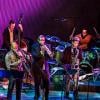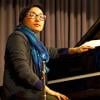
Back in March, SFJAZZ hosted a community forum for Bay Area musicians, many of whom expressed frustration at the organization’s seeming lack of interest in showcasing original music by the region’s resident artists. In the meeting’s aftermath there have been a few signs that SFJAZZ’s doors are opening, like the Nov. 4 Joe Henderson Lab premiere of El Cerrito trumpeter Ian Carey’s Fire in My Head (The Anxiety Suite), an extended work written with the support Chamber Music America’s 2016 New Jazz Works program.
But for a wholehearted embrace of new music emanating from the local jazz scene look across the Bay to Berkeley’s California Jazz Conservatory, which recently launched a weekly concert series called Way Out West. Focusing on Bay Area ensembles creating new music, the series “was inspired in part by some of the discussions that were happening around SFJAZZ,” says Rob Ewing, the trombonist, bassist, and director of the CJC’s Jazzschool Community Music School.
With support from pianist Susan Muscarella, the conservatory’s founder and president, Ewing launched the Tuesday night series in the school’s new Rendon Hall. So far, it’s off to a rip-roaring start. Way Out West kicked off on Oct. 2 with drummer Alan Hall’s Ratatet, a polymorphous ensemble that brings together a striking cast of singular players. Originally a sextet, Ratatet has evolved into a body of original music rendered by a continually shifting array of musical constellations from duo to septet, and the Rendon Hall performance seemed to embody Way Out West’s protean sense of possibility.
With nary a solo, Hall’s What Was the Question? unfolded as a bright but melancholy through-composed soundscape for a trio with vibraphonist Dillon Vado, bassist Jeff Denson, and Sheldon Brown on clarinet. Brown sat out for the turbulent Incitement, a sextet piece introduced by Greg Sankovich’s percussive piano that climaxed with a torrential duet with Hall and Paul Hanson’s effects-processed bassoon. And so it went throughout the set, with Hall featuring a bespoke lineup for tunes mostly drawn from the recent Ratatet album Heroes, Saints and Clowns.
Last week, the Klaxon Mutant Allstars, another mid-sized ensemble that has fully incorporated electronic processing, played a similarly revelatory Way Out West set. Featuring Henry Hung on trumpet and effects, Kasey Knudsen on alto sax and effects, Jonathan Herrera on bass, and effects, drummer Eric Garland, and Colin Hogan on piano and keyboards, the band alternated between original pieces and arrangements of thoroughly reimagined 1980’s pop hits like a reverently coruscating ride through “Everybody Wants to Rule the World” by Tears for Fears. Judging by the music presented so far, the state of the Bay Area scene is strong indeed.
It’s no coincidence that Ewing borrowed the name of Sonny Rollins’s classic 1957 Contemporary piano-less trio album Way Out West, a session almost as famous for its iconic William Claxton photo of the tenor sax titan decked out in Western garb as for its wide-open harmonic vistas. “I like what that combination of words suggests,” says Ewing, an inveterately curious musician known for his work as the leader of Disappear Incompletely — The Radiohead Project and the Electric Squeezebox Orchestra, which continues its weekly Sunday residency at the CJC. “I was thinking about some kind of West-Coast emphasis. There’s something interesting going on out here and with the album’s boundary pushing and sense of experimentalism, I thought that title summed it up nicely. And of course, it’s a favorite.”
The Bay Area scene is far too diverse to identify overarching trends, but one pronounced direction is an increasing inclusion of electronics into improvisational settings with orthodox jazz instrumentation. On Oct. 30, clarinetist Ben Goldberg joins Jon Arkin on drums and effects, a duo that evolved out of Golberg’s work as a guest artist on 2016’s Broken Home, the second album by the Schimscheimer Family Trio (with Arkin, Kasey Knudsen, and keyboardist Michael Coleman). It’s another situation where acoustic improvisation blends with real-time electronic processing.

“Eli Crews produced Broken Home really heavily with effects that I dug, and I got into trying to reverse engineer a lot of stuff from that album,” says Arkin, who also performs with Ian Carey’s Quintet Plus One at the SFJAZZ Center premiere on Nov. 4, and again at Rendon Hall for a Nov. 13 Way Out West concert with a trio featuring Knudsen and bassist Miles Wick.
“I plunged headfirst into programming and live processing and developed my own project around that,” Arkin continues. “I liked having a more organic component with Ben. He’s such a pure improviser. One of the intentional things is to have enough structure so it’s not completely free improv. It’s really unpredictable, with elements that don’t necessarily go together and we’re trying to make them work.”
Part of Ewing’s concept for Way Out West is to provide musicians with audio and video recordings they can use to seek other gigs at venues and festivals. “I’m really interested in bringing attention to the Bay Area scene as a whole,” he says.
It’s understandable that Bay Area musicians want to feel endorsed by SFJAZZ, but the international scope of the organization’s vision is more akin to a Cal Performances and Stanford Live. The CJC is an invaluable presenter for touring musicians overlooked by SFJAZZ, but the school focuses resolutely on the local community, and Way Out West reflects the priorities of an artist at the center of the Bay Area scene.
“Rob has his thumb on the pulse of the scene more than most,” Arkin says. “I’m so grateful he’s in the position he’s in. I’ve brought him ideas for workshops and he’s always excited to try them out. There’s a real shortage of venues where you can do certain kinds of music. You can play Studio Grand or the Luggage Store, but Rendon Hall is a perfect venue to bring more attention to the great musicians who live here.”
Details and tickets for upcoming Way Out West concerts are available at the California Jazz Conservatory concert page.




